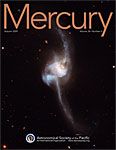Autumn 2009 - Volume 38, Number 4

Table of Contents
[13] ASP Annual Meeting: Report to the Membership, James G. Manning
Here is a capsule summary of the Executive Director’s report to the members, outlining some of the numerous programs undertaken by your Society during the previous 12 months.
[20] Laboratory Astrophysics: An Oxymoron No More, Bruce Partridge
Laboratory astrophysics, the branch of astronomy that attempts to replicate astronomical processes in the laboratory, has taken a new path.
[21] 400 Years of Astronomical Discovery, Lynne Hillenbrand
From Galileo to today, and on into the foreseeable future, it’s clear that advancement in astronomy is driven by the interaction between technology, observation, and interpretation.
[30] Astronomy in the News
Another meteorite found on Mars, a new ring for Saturn, and a celestial Rosetta stone — these are some of the discoveries that have recently made news in the astronomical community.
Departments
[4] Editorial, Paul Deans
How Do You Read Your Mercury?
[5] First Word, James G. Manning
Following Your "Bliss" in the IYA
[7] Astronomer's Notebook, Jennifer Birriel
The Long-term Solar Forecast
[8] Planetary Perspectives, Daniel D. Durda
Going With the Flow
[9] Echoes of the Past, Katherine Bracher
50 Years Ago: Classifying Galaxies
[10] Annals of Astronomy, Clifford J. Cunningham
Was Galileo Really First?
[11] Education Matters, David Bruning
Learning Styles in Astro 101
[12] Societal Impact, Bruce Partridge
Tweaking the ASP's Board
[37] Society Scope/ASP New Members
Meet Your New Board Members
[42] Sky Sights, Paul Deans
The Sky of November, December, and January
[45] Reflections, Martin Ratcliffe
A White House Star Party
ASP Annual Meeting: Report to the Membership
by James G. Manning
Every year at the Annual Meeting of the Astronomical Society of the Pacific (held most recently this past September in Millbrae, just south of San Francisco), I present a report outlining some of the numerous programs undertaken by your Society during the previous 12 months. Many of these activities appear on various pages in our website and within the pages of our quarterly publication Mercury.
Since most ASP members were unable to attend the Annual Meeting, the editor of Mercury thought it would be appropriate if I reprised my talk within the pages of this magazine -- but not simply as a regular article. So rather than trying to recapture my words and put them to paper, a number of key slides from my PowerPoint presentation are recreated on the following pages.
Laboratory Astrophysics: An Oxymoron No More
by Bruce Partridge
I was asked to begin by framing the discussion, and I propose to do so by starting with a two-word oxymoron, an oxymoron that for millennia might have seemed blasphemous as well as puzzling. It is this: "laboratory astrophysics." This is the branch of astronomy that attempts to replicate astronomical processes in the laboratory.
To anyone who believes, as most of Galileo's contemporaries did, that the heavens are governed by completely different physical laws from mundane, earthly events, the idea of "laboratory astrophysics" would make no sense. Indeed, given that the mechanics of the heavens were supposedly perfect and divine, it would even smell of blasphemy.
400 Years of Astronomical Discovery
by Lynne Hillenbrand
We are about three-quarters of the way through the IYA, the International Year of Astronomy. It is thus timely to think about the successes of the year and, as this ASP annual meeting title indicates, forge a path to a future of continued public engagement in astronomy.
In this context of public understanding and appreciation of science, it is important to note the world view into which Galileo Galilei was born (1564). The accepted cosmology was that there were two very separate realms: that of the Earth, consisting of soil/earth, air, fire, and water and on which all was transient, and that of the heavens or Heaven, consisting of a perfect regularity -- remote from Earth's imperfections, and eternal.
Astronomy in the News
Spitzer Spots Clump of Planetary Material
NASA / JPL
Astronomers have witnessed odd behavior around a young star. Something, perhaps another star or a planet, appears to be pushing a clump of planet-forming material around. The observations, made with NASA's Spitzer Space Telescope, offer a
rare look into the early stages of planet
formation.
Planets form out of swirling disks of gas and dust. Spitzer observed infrared light coming from one such disk around a young star, called LRLL 31, over a period of five months. To the astronomers' surprise, the light varied in unexpected ways, and in as little time as one week. Planets take millions of years to form, so it's rare to see
anything change on time scales we humans can perceive.
One possible explanation is that a close companion to the star — either a star or a developing planet — could be shoving planet-forming material together, causing its thickness to vary as it spins around the star. "We don't know if planets have formed, or will form, but we are gaining a better understanding of the properties and dynamics of the fine dust that could either be-come, or indirectly shape, a planet," said James Muzerolle of the Space Telescope Science Institute, Baltimore, Md. "This is a unique, real-time glimpse into the lengthy process of building planets."
The observations showed that light from the inner region of the star's disk changes every few weeks, and, in one instance, in only one week. "Transition disks are rare enough, so to see one with this type of variability is really exciting," said co-author Kevin Flaherty of the University of Arizona, Tucson.
